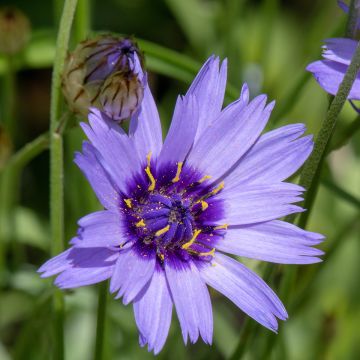

Chrysanthème des Moissons Bio - Ferme de Sainte Marthe


Chrysanthème des Moissons Bio - Ferme de Sainte Marthe


Chrysanthème des Moissons Bio - Ferme de Sainte Marthe
Chrysanthemum segetum - Corn Marigold
Chrysanthemum segetum
Corn Marigold, Corn Daisy, Field Marigold
These little seeds have kept their promises. They gave me a small bed of lovely yellow flowers all summer long, allowing me to create pretty mini bouquets that hold up well in a vase. I will start again next year.
Françoise , 09/10/2024
Special offer!
Receive a €20 voucher for any order over €90 (excluding delivery costs, credit notes, and plastic-free options)!
1- Add your favorite plants to your cart.
2- Once you have reached €90, confirm your order (you can even choose the delivery date!).
3- As soon as your order is shipped, you will receive an email containing your voucher code, valid for 3 months (90 days).
Your voucher is unique and can only be used once, for any order with a minimum value of €20, excluding delivery costs.
Can be combined with other current offers, non-divisible and non-refundable.
Home or relay delivery (depending on size and destination)
Schedule delivery date,
and select date in basket
This plant carries a 6 months recovery warranty
More information
We guarantee the quality of our plants for a full growing cycle, and will replace at our expense any plant that fails to recover under normal climatic and planting conditions.
Would this plant suit my garden?
Set up your Plantfit profile →
Description
The Corn Marigold, also known as the Golden Daisy, Field Marigold, or Chrysanthemum segetum in Latin, is an annual plant found in harvested fields that offers a very long, absolutely radiant yellow flowering, highly visited by pollinators. It forms a bushy clump with abundant flowers throughout the season until early autumn. Perfect in slightly wild areas of the garden, its flowers hold up well in bouquets. This flower thrives in the sun, in loose, sandy or clayey soil, even when dry, but without limestone.
This Chrysanthemum segetum is an annual plant native to North Africa and the eastern Mediterranean basin, now widespread in many temperate regions, including France. This species, officially called Glebionis segetum, is also known as corn marigold or cornflower in different regions. Reaching a height of 45 to 55 cm (18 to 22in), depending on growing conditions, it has an erect and branched habit. Flowering occurs from June to October, above a well-furnished foliage. Its inflorescences are large solitary heads measuring 4 to 6 cm (2in) in diameter, carried on thickened branches at the top. They are a beautiful bright yellow, more or less orange or golden, and highly visited by pollinating insects. The foliage differs depending on its position on the stem; the lower leaves are deeply divided towards the base, narrowed into petioles, while the upper leaves are oblong-lanceolate, embracing, toothed or entire. Their colour is a glaucous green, slightly bluish or grayish. The abundantly produced seeds are a delight for birds. This plant easily self-seeds in well-worked soil, but not limestone.
Originally from the Mediterranean, Corn Marigold thrives in warmth, sunlight, and rather acidic or sandy soils. It is ideal for creating a natural garden or low-maintenance flower beds. It can be paired with annual cornflower (Centaurea cyanus), milk thistle (Silybum marianum), alfalfa (Medicago sativa), phacelia (Phacelia tanacetifolia), or dame's rocket (Hesperis matronalis) to feed bees and butterflies. It can also be grown in a large pot, provided it is pinched often to give it a more compact habit. The flowers, which hold up well in bouquets, also provide a yellow dye.
Chrysanthemum segetum - Corn Marigold in pictures






Flowering
Foliage
Plant habit
Botanical data
Chrysanthemum
segetum
Asteraceae
Corn Marigold, Corn Daisy, Field Marigold
Mediterranean
Other Thompson and Morgan seeds
View all →Planting and care
Sowing:
Sow the seeds of corn marigold outdoors, in place, preferably in April-May. Choose a sunny location on well-drained soil, prepared and properly loosened. Sow the seeds finely, at a depth of 3mm (0in), in furrows or holes, with a spacing of 30 cm (12in). Water regularly, especially during dry periods. Germination usually takes 14 to 21 days. When the plants are large enough to handle, thin and transplant them at a distance of 40 cm (16in) from each other.
Cultivation:
Corn marigold prefers well-worked soils, fairly fertile although it can tolerate poor, sandy soils or arable soils that are low in or devoid of limestone. It is a heliophilous plant that will only thrive in a very sunny exposure. At the end of the season, you can let a few heads produce seeds to feed the birds or keep a supply of seeds for planting the following year.
Sowing period
Intended location
Planting & care advice
-
, onOrder confirmed
Reply from on Promesse de fleurs
Haven't found what you were looking for?
Hardiness is the lowest winter temperature a plant can endure without suffering serious damage or even dying. However, hardiness is affected by location (a sheltered area, such as a patio), protection (winter cover) and soil type (hardiness is improved by well-drained soil).

Photo Sharing Terms & Conditions
In order to encourage gardeners to interact and share their experiences, Promesse de fleurs offers various media enabling content to be uploaded onto its Site - in particular via the ‘Photo sharing’ module.
The User agrees to refrain from:
- Posting any content that is illegal, prejudicial, insulting, racist, inciteful to hatred, revisionist, contrary to public decency, that infringes on privacy or on the privacy rights of third parties, in particular the publicity rights of persons and goods, intellectual property rights, or the right to privacy.
- Submitting content on behalf of a third party;
- Impersonate the identity of a third party and/or publish any personal information about a third party;
In general, the User undertakes to refrain from any unethical behaviour.
All Content (in particular text, comments, files, images, photos, videos, creative works, etc.), which may be subject to property or intellectual property rights, image or other private rights, shall remain the property of the User, subject to the limited rights granted by the terms of the licence granted by Promesse de fleurs as stated below. Users are at liberty to publish or not to publish such Content on the Site, notably via the ‘Photo Sharing’ facility, and accept that this Content shall be made public and freely accessible, notably on the Internet.
Users further acknowledge, undertake to have ,and guarantee that they hold all necessary rights and permissions to publish such material on the Site, in particular with regard to the legislation in force pertaining to any privacy, property, intellectual property, image, or contractual rights, or rights of any other nature. By publishing such Content on the Site, Users acknowledge accepting full liability as publishers of the Content within the meaning of the law, and grant Promesse de fleurs, free of charge, an inclusive, worldwide licence for the said Content for the entire duration of its publication, including all reproduction, representation, up/downloading, displaying, performing, transmission, and storage rights.
Users also grant permission for their name to be linked to the Content and accept that this link may not always be made available.
By engaging in posting material, Users consent to their Content becoming automatically accessible on the Internet, in particular on other sites and/or blogs and/or web pages of the Promesse de fleurs site, including in particular social pages and the Promesse de fleurs catalogue.
Users may secure the removal of entrusted content free of charge by issuing a simple request via our contact form.
The flowering period indicated on our website applies to countries and regions located in USDA zone 8 (France, the United Kingdom, Ireland, the Netherlands, etc.)
It will vary according to where you live:
- In zones 9 to 10 (Italy, Spain, Greece, etc.), flowering will occur about 2 to 4 weeks earlier.
- In zones 6 to 7 (Germany, Poland, Slovenia, and lower mountainous regions), flowering will be delayed by 2 to 3 weeks.
- In zone 5 (Central Europe, Scandinavia), blooming will be delayed by 3 to 5 weeks.
In temperate climates, pruning of spring-flowering shrubs (forsythia, spireas, etc.) should be done just after flowering.
Pruning of summer-flowering shrubs (Indian Lilac, Perovskia, etc.) can be done in winter or spring.
In cold regions as well as with frost-sensitive plants, avoid pruning too early when severe frosts may still occur.
The planting period indicated on our website applies to countries and regions located in USDA zone 8 (France, United Kingdom, Ireland, Netherlands).
It will vary according to where you live:
- In Mediterranean zones (Marseille, Madrid, Milan, etc.), autumn and winter are the best planting periods.
- In continental zones (Strasbourg, Munich, Vienna, etc.), delay planting by 2 to 3 weeks in spring and bring it forward by 2 to 4 weeks in autumn.
- In mountainous regions (the Alps, Pyrenees, Carpathians, etc.), it is best to plant in late spring (May-June) or late summer (August-September).
The harvesting period indicated on our website applies to countries and regions in USDA zone 8 (France, England, Ireland, the Netherlands).
In colder areas (Scandinavia, Poland, Austria...) fruit and vegetable harvests are likely to be delayed by 3-4 weeks.
In warmer areas (Italy, Spain, Greece, etc.), harvesting will probably take place earlier, depending on weather conditions.
The sowing periods indicated on our website apply to countries and regions within USDA Zone 8 (France, UK, Ireland, Netherlands).
In colder areas (Scandinavia, Poland, Austria...), delay any outdoor sowing by 3-4 weeks, or sow under glass.
In warmer climes (Italy, Spain, Greece, etc.), bring outdoor sowing forward by a few weeks.




















































